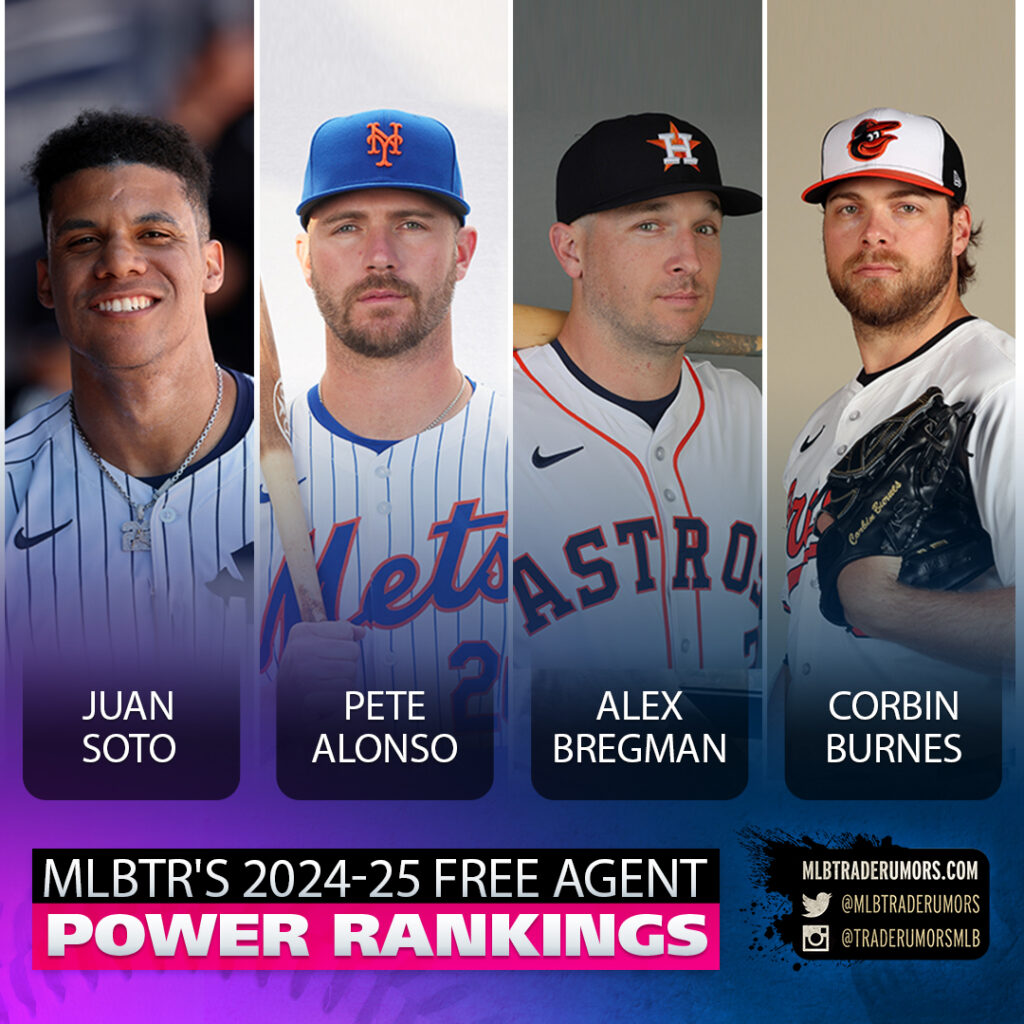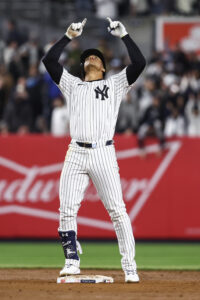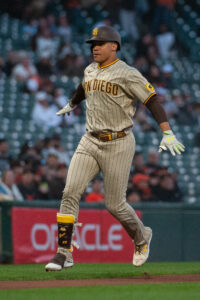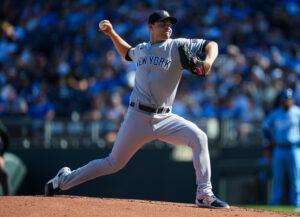The season is underway, which makes this a good time to look ahead to next winter with the first installment of the 2024-25 MLB Free Agent Power Rankings! It’s an annual series here at MLBTR, wherein we try to rank the upcoming class of free agents by measure of their estimated earning power.
MLBTR will take periodic looks at the top of the class from now through the remainder of the season. Season performance will start to influence these rankings, but two to three weeks into the season, it’s not a huge factor. By the end time the season draws to a close, however, 2024 results will weigh heavily into the rankings. A strong platform year can elevate any player’s status in free agency, just as a poor walk year can tank their stock.
Our power rankings are compiled collaboratively. I worked with colleagues Anthony Franco and Darragh McDonald as well as MLBTR founder and owner Tim Dierkes for the first installment of this year’s rankings. Players with opt-out clauses and player options are included, even if they’ve previously given indications they may forgo the opportunity to return to the market.
Statistics are up-to-date through April 12.
* denotes players who are ineligible for a qualifying offer
1. Juan Soto, OF, Yankees
Were it not for Shohei Ohtani reaching the open market a year sooner, Soto might have a claim to the most coveted free agent ever. Because he skyrocketed through the minor leagues and took MLB by storm beginning at age 19, Soto’s final year of arbitration eligibility comes in just his age-25 campaign. He’ll play the entirety of his first free agent season at 26 years of age. For some context, Aaron Judge — who re-signed on a nine-year, $360MM contract with the Yankees upon reaching free agency — debuted at 24 and had 773 big league plate appearances heading into his own age-26 season.
Soto is a freak of nature who was one of MLB’s best hitters at an age when most top prospects are still in college or just entering the low minors. He hit .292/.406/.517 as a teenage rookie in 2018, and his preternatural plate discipline, bat-to-ball skills and raw power have only improved since. Through more than 3400 career plate appearances, Soto has walked at a staggering 18.9% clip and struck out in just 17% of his plate appearances. He entered the current season with 160 home runs, and while he’s never had a 40-homer campaign before, a move to Yankee Stadium and its notorious short porch in right field could help him get to 200 long balls before he turns 26.
Since his 2018 debut, Soto leads qualified big leaguers with a mammoth .422 on-base percentage. Mike Trout’s .415 mark ranks second, and Freddie Freeman (.402) is the only other hitter north of .400. Soto is “only” 16th in home runs in that time, but his 154 wRC+ — which indicates he’s been 54% better than an average hitter after weighting for home park and league run-scoring environment — is tied with Mookie Betts for fourth-best in baseball, trailing only Trout, Yordan Alvarez and Judge.
If there’s one wart to Soto’s game, it’s that he’s limited to the outfield corners and isn’t regarded as an especially strong defender. He’s had seasons with positive grades from both Defensive Runs Saved and Outs Above Average, but on the whole he has negative marks from both in his career — both in left field and in right field. That said, he’s also only had two truly *bad* seasons per both of those metrics, and taken in totality, he sits around -2 DRS and -4 OAA per season. Obviously, that’s not great, but it’s also not exactly egregious. And given the otherworldly contributions he makes at the plate, playing a slightly below-average left or right field is more than an even trade-off.
Soto famously rejected a 14-year, $440MM extension offer from the Nationals before being traded to the Padres. Rejecting an offer of that magnitude led to plenty of jaws dropping, but when considering that it included his three final arbitration seasons and 11 free agent years, it’s not as jarring as it seems at first blush. Soto wound up earning $71.1MM over those three seasons, meaning he really “only” needs to earn $370MM or so in free agency to come out ahead. There’s already talk of a potential $500MM free-agent deal for Soto. Barring a catastrophic injury, he’ll likely come out ahead in that bet on himself. He’s the clear No. 1 free agent on next year’s market and will be one of the most sought-after free agents not only in baseball history but in all of professional sports.
2. Corbin Burnes, RHP, Orioles
Since his 2020 breakout, Burnes ranks fifth in the majors in innings pitched, eighth in strikeout rate, fourth in K-BB%, second in opponents’ batting average, fifth in ERA, second in FIP and third in SIERA. Put another way — regardless of which metric you prefer to judge pitchers, Burnes ranks in the top-eight in just about any metric. He’s a bona fide No. 1 starter — very arguably one of the five best pitchers the sport has to offer at the moment.
Detractors might point to Burnes’ 2023 numbers as the potential beginning of a decline. His 3.39 ERA, 25.5% strikeout rate and 8.4% walk rate were all more “very good” than elite. Through three starts in Baltimore, he’s trending back in the other direction. Small sample caveats obviously apply, but Burnes has opened his first season with his new club on a tear, tossing 18 2/3 innings of 1.93 ERA ball with a 28.6% strikeout rate and superlative 2.9% walk rate. His velocity is as strong as ever; his devastating cutter is averaging 95.1 mph — an exact match for his career-best mark, set back in 2021 when he won the National League Cy Young Award.
Burnes won’t turn 30 until October. He’s never been on the injured list due to an arm issue. His only IL stints were due to an oblique strain and Covid. Burnes might not be quite as dominant as he was when he was striking out more than 35% of his opponents from 2020-21, but he’s a workhorse ace and former Cy Young winner who still ranks among the game’s elite arms. Gerrit Cole’s nine-year deal with the Yankees began in his age-29 season. Teams have generally been wary of committing to long-term deals for pitchers that span beyond their age-37 season (though there are exceptions, as evidenced by Jacob deGrom’s current five-year deal).
Burnes is dominant enough that he could prove to be an exception, but even if he’s limited to eight-year terms, he’ll have a chance at surpassing a $250MM guarantee. With a big enough year, nine years and/or $300MM+ could be on the table.
3. Alex Bregman, 3B, Astros
Bregman would’ve hit free agency in the 2022-23 offseason were it not for a five-year, $100MM extension he signed upon first reaching arbitration. That locked in his first — but very likely not his last — nine-figure contract and still allowed him to hit the open market at a fairly standard point, heading into his age-31 season.
There’s perhaps a perception that Bregman is declining or trending in the wrong direction, as his production has dipped from the MVP-caliber levels he displayed in 2018-19. He also doesn’t have the most appealing batted-ball profile, which we saw work to Cody Bellinger’s detriment in free agency this offseason. Bregman’s 88.6 mph average exit velocity and 38.2% hard-hit rate in 2023 were both pretty pedestrian marks.
One key difference between Bregman and Bellinger, however, is that Bregman has never had gaudy Statcast numbers — even when he was putting up the type of numbers that led to consecutive All-Star nods and top-five MVP finishes in 2018-19. Bellinger, on the other hand, previously had top-of-the-scale exit velo and hard-hit numbers, leading to more questions about whether his resurgent 2023 showing was truly sustainable.
Bregman has always possessed sensational contact skills. He’s never fanned at higher than a 15.5% clip in a full season. The former No. 2 overall draft pick legitimately possesses one of the best hit tools in all of baseball. He couples that with elite plate discipline, too; Bregman has walked at a 12.6% clip in his career and a 13.7% rate dating back to 2018. He’s walked more than he’s struck out in four individual seasons and in the aggregate from 2018-24. His 41-homer campaign from 2019 looks like a clear outlier in what’s now known as the juiced-ball season, but Bregman still popped 48 homers from 2022-23.
Some may question how much power he can manufacture following a potential change of scenery. Minute Maid Park’s short porch in left field — the Crawford Boxes — seems practically tailor-made for Bregman’s fly-ball heavy, pull-side approach. (Or, perhaps alternatively, he reworked his swing to take advantage of that quirk in his home park.)
There’s little doubting that he’s had some home runs that are Crawford Box specials over the years, but a look at Bregman’s career splits don’t paint the picture of someone who is a product of his hitter-friendly home environment. Bregman’s a career .273/.377/.473 hitter in Houston and a .275/.368/.498 hitter on the road. He’s actually hit nine more homers on the road in his career despite having only 64 more plate appearances away from Minute Maid Park than at home.
Defensively, Bregman isn’t an elite third baseman, but he’s posted average or better marks in DRS and OAA nearly every season of his career. There’s no reason to expect a position change in the near future, but if he does need to move off the hot corner at some point, a shift to second base, left field or first base seems feasible for the former shortstop. And as someone who’s been 36% better than average at the plate in his career — and 25% better dating back to 2020 — he has more than enough bat to profile as a regular anywhere on the diamond.
A seven- or eight-year deal seems plausible in free agency, and there’s always the chance that a luxury-paying team will gauge his interest in a longer-term deal with a non-premium AAV in order to tamp down the CBT hit. A deal north of $200MM seems plausible for Bregman. The Astros have said at multiple points in the past they’ll make an extension offer at some point, but there haven’t been serious talks on that front yet and Bregman can justifiably seek the type of long-term pact that owner Jim Crane has completely avoided over the years.
4. Pete Alonso, 1B, Mets
The Polar Bear is raw personified, bashing 40-plus homers on the regular since his 2019 debut. Alonso has not only established himself as one of baseball’s premier sluggers — he’s done so while maintaining a strikeout rate that’s lower than the league average. At a time when many prodigious sluggers are comfortable selling out for power, Alonso has the type of easy, plus-plus power that doesn’t require him to do so. He’s fanned in just 20.7% of his plate appearances dating back to 2021 and popped the fifth-most long balls in baseball along the way. He trails only Aaron Judge, Matt Olson, Kyle Schwarber and Shohei Ohtani in that span. All four of those sluggers have whiffed at higher rates than Alonso.
Alonso’s extreme fly-ball approach does lead to a glut of pop-ups and some low BABIPs — though last year’s bottom-of-the-barrel .205 average on balls in play (and .217 average overall) were likely outliers. He’s a career .250 hitter who walks at around a 10% clip — enough to boost his OBP into the .340 range most seasons. Paired with his prodigious power, that’s plenty to make Alonso one of the most feared hitters in the National League.
After debuting as a 24-year-old back in 2019, Alonso is on pace to hit the open market heading into his age-30 season. He’s not unusually young like Soto but is reaching free agency at the same point that’s seen plenty of sluggers get paid. He’ll be two years younger than Freddie Freeman and Paul Goldschmidt were when signing their current contracts (Freeman’s in free agency, Goldschmidt’s as an extension). That pair of contracts pays those star first basemen $26-27MM annually.
Alonso isn’t as good a pure hitter as either Freeman or Goldschmidt, nor is he the same defensively. He’s consistently graded out as a sub-par defender, per OAA, and a roughly average first baseman by measure of DRS. But Alonso is younger, has more power than either of those two former MVPs, and has the benefit of Mets owner Steve Cohen likely being extra-motivated to keep his franchise slugger. It wouldn’t be at all surprising to see Alonso follow a similar path to Judge. That’s not to say he’ll sign a $360MM deal — he won’t — but he could reject a qualifying offer, explore what the market has to offer, and then take the top offer back to the Mets and effectively ask that they match it.
A six-year deal would run through Alonso’s age-35 season. Seven years would take him through age-36. Either of those terms feels plausible, as does an AAV in the vicinity of — or even slightly in excess of — the Freeman and Goldschmidt deals.
5. Blake Snell, LHP, Giants*
Will the second time prove to be a charm for Snell? The $200MM+ contract he sought in free agency this past winter never materialized, likely due to a confluence of factors. Beyond the sheer scope of his ask, Snell hit free agency at a time when roughly half the league was experiencing uncertainty regarding its long-term television status. We’re also slated for a record number of CBT payors, including several big spenders — Yankees, Dodgers, Mets — currently paying a 110% tax that made a long-term deal for Snell wholly unpalatable. Further yet, recent high-profile spenders like the Padres, Rangers, Red Sox, Blue Jays and Mets all took steps back in terms of their aggression.
None of that even touches on Snell’s command troubles, though his penchant for issuing free passes hasn’t stopped him from dominating opposing lineups over the past several seasons. Snell is now a two-time Cy Young winner — one of just 22 in MLB history — who’ll spend the 2024 season pitching in an even more spacious home park than he enjoyed in San Diego.
Snell will turn 32 in the coming offseason, so he won’t have age on his side. But he already rejected a qualifying offer from the Padres, meaning he’s ineligible to receive another one at any point in his career. That lack of draft pick compensation will be a bonus, and it’s possible next offseason’s market will bear more favorable circumstances. If the Mets, Red Sox, Rangers or Padres begin spending again and if even a couple of CBT payors are suddenly in position to dip back under the threshold, Snell could find more suitors this time around.
He’s not a lock to hit the market, of course. Snell’s two-year $62MM deal with the Giants allows him to opt out at season’s end, leaving a $30MM player option on the table. So long as he remains healthy and effective, he’ll be a lock to do so. The left-hander ranks 11th in ERA (3.05) and seventh in strikeout rate (31.7%) among qualified big league starters dating back to the 2018 season. He’s had a couple rough seasons along the way, but the broader body of work is genuinely excellent.
As previously mentioned, teams are typically wary of committing beyond a starting pitcher’s age-37 season. For Snell, hitting the market at 32, that’d make it tough to secure a contract lengthier than six years. A six-year deal checking in at $28MM or more would allow Snell to still claim that he topped $200MM in free agent earnings (when combined with his current $32MM in earnings). That type of offer seemingly wasn’t there this time around, but if Snell turns in a third straight dominant season — he had a 2.72 ERA and 31.7% strikeout rate in 2022-23 — someone’s likely going to pony up with a big offer.
6. Max Fried, LHP, Braves
Few starters in baseball have been as consistent as Fried on a year-to-year basis. The former No. 7 overall draft pick has turned in a sub-3.00 ERA in three of the past four seasons, with the lone exception being a 3.04 mark in 2021. Fried’s strikeout rate has fallen between 22.3% and 25.7% for five straight seasons. His walk rates in that time have landed between 4.4% and 8.5% (though that 8.5% came in 2020’s short season and is something of an outlier, he’s been under 7% in every other full season). His ground-ball rate sits between 51.2% and 57.7% each year.
Fried isn’t an overpowering ace in the sense that he hits triple digits with his heater and strikes out a third of his opponents. He has above-average but not elite velocity, leading to average or slightly better strikeout rates. However, Fried has plus command and ground-ball tendencies, and he dodges hard contact at consistently excellent levels.
Prior to the 2023 season, Fried was also quite durable, ranking 19th in the majors in innings pitched and 21st in games started. That doesn’t include his 10 postseason starts (and four relief outings) — a total of 58 2/3 additional innings. A forearm strain suffered in early May last year, however, knocked Fried out of action for about three months. Though he was characteristically excellent when health — 2.55 ERA, 3.14 FIP, 3.38 SIERA — Fried was limited to 14 starts and 77 2/3 innings.
Proving that forearm strain is behind him will be paramount to his free agent platform. Another 30-plus starts won’t completely eliminate any trepidation stemming from last year’s injury, but another season with considerable missed time — particularly due to an arm injury of any nature — would create cause for clear concern.
Fried has been more durable than Carlos Rodon (six years, $162MM with the Yankees) and has a far lengthier track record of success. He and his reps will likely take aim at toppling that mark in free agency. Braves fans would surely like to see an extension, but it hasn’t happened in the past, and Fried is plenty justified in asking for the type of long-term deal and semi-premium AAV that the Braves have steered clear of in recent years. He seems likelier to follow Freddie Freeman and Dansby Swanson out the door than he does to receive an extension offer that’s commensurate with his market value.
7. Cody Bellinger, OF/1B, Cubs*
Bellinger didn’t get the mega-deal he sought this past offseason. Excellent as his 2023 campaign was, there were surely teams wary of his woeful 2021-22 showing on the heels of shoulder surgery. Beyond that, his exit velocity, hard-hit rate and other batted-ball metrics were decidedly pedestrian.
Agent Scott Boras has pointed to Bellinger’s massive decline in strikeout rate as a factor, painting his client as a hitter who adopted a two-strike approach more focused on putting the ball in play than on doing massive damage. There’s surely a blend of truth and garden-variety agent spin woven into that defense.
A repeat of his 2023 production — or anything close to it — would strengthen Bellinger’s case immensely. It’d further distance him from that awful 2021-22 showing, lending further credence to the notion that injuries played a significant role in his perceived decline. And whether Bellinger replicates his numbers by returning to his maximum-damage approach or simply proves that his newer brand of more well-rounded, low-strikeout offense is sustainable, either approach should prove lucrative.
Even though an opt-out would trigger Bellinger’s third trip to free agency, he’ll still be heading into just his age-29 season next year. He can still play a fine center field (or corner outfield, presumably) and remains a good option at first base as well. There’s plenty of defensive and baserunning value to supplement his bat.
Bellinger will pocket $30MM in the first season of his three-year, $80MM deal with the Cubs, meaning he’ll be opting out from two years and $50MM. That seems likely, barring a 2021-22-esque collapse or a massive injury. Because of his age, that immense long-term deal that eluded him this past offseason still feels plausible. That he can no longer be saddled with a qualifying offer — players can only receive one in their career, and he rejected one last offseason — only strengthens his case.
8. Willy Adames, SS, Brewers
Adames joins Javier Baez, Trevor Story and Dansby Swanson as the latest in a line of high-end shortstops to reach free agency heading into his age-29 season. That trio signed for respective guarantees of $140MM (Tigers), $140MM (Red Sox) and $177MM (Cubs). Adames doesn’t have the individual accolades that group possesses. He’s never been an All-Star like each of that trio has. He hasn’t won Gold Gloves like Swanson and Baez. He hasn’t won the Silver Sluggers that Story has.
Yet despite the lack of hardware, Adames has a strong claim to be valued in similar fashion. It’s true that he had a down year at the plate in 2023, but that was in part driven by a career-low .250 average on balls in play. Since 2020, Adames is a .240/.316/.450 hitter. He’s been 8% better than average overall, by measure of wRC+, and he peaked with a 121 wRC+ (21% better than average) from 2020-21. Adames fanned at a sky-high 36.1% back in 2020 but has reduced that mark considerably; over his past 1300 plate appearances he’s punched out at a worse-than-average but far more manageable 26.2% rate. He struggled badly against lefties early in his career (despite being a right-handed hitter) but has improved against them in recent seasons.
From 2021-23, Adames averaged 26.67 homers per season — topping out at 31 round-trippers in 2022. He’s walked at an above-average but not elite 9.4% rate in his career — including a personal-best 11.1% in 2023. Adames has long been touted as having plus defensive tools, but his execution and consistency were lackluster early on, leading to some middling grades. Over the past two seasons he’s been outstanding, tallying 17 DRS and a flat-out elite 26 OAA.
If Adames can bounce back from last year’s .217/.310/.407 line and turn in something closer to the .251/.319/.471 slash he logged from 2020-22, he’ll have an easy case to be paid comparably to Story, Baez and Swanson. He’s likely to hit the market on the heels of four straight 20-homer campaigns. He’s a plus defender. He’s relatively young. He’s not the most consistent hitter on a year-over-year basis, but that was true of Baez, Story and Swanson. They all got paid. Adames will also draw bonus points for his gregarious personality and leadership skills. Both the Rays and Brewers have lauded him in that regard, and the primary reason Tampa Bay traded him — Wander Franco’s looming emergence — now looks regrettable (even if getting Drew Rasmussen in return for him has yielded plenty of value).
9. Ha-Seong Kim, SS/2B, Padres
Kim came to MLB with great fanfare as a 25-year-old KBO superstar who’d been posted by the Kiwoom Heroes. He signed a four-year, $28MM deal with San Diego that contains a mutual option for a fifth season. Mutual options are generally accounting measures and are almost never exercised by both parties. In Kim’s instance, it’s a no-brainer to decline his end of the option and hit free agency in search of a deal that could pay him three to four times his original MLB guarantee.
While Kim’s rookie season didn’t live up to the hype, he’s since acclimated to MLB quite nicely. Now 28, he posted a .256/.338/.391 batting line (109 wRC+) from 2022-23. His power has increased in each MLB season, resulting in a career-high 17 homers last year, and he swiped a hefty 38 bases in 47 tries for the Friars last season. Kim’s walk rate has climbed every MLB season as well, topping out at a robust 12% in 2023, and after fanning in 23.8% of his plate appearances as a rookie he’s dropped that mark to 18.5% in 2022-23.
Decent power, strong on-base skills and plus speed give Kim plenty of appeal, but his glove is perhaps his greatest selling point. Kim is an elite defensive infielder capable of handling any of second base, shortstop or third base. He won his first Gold Glove for his play at second base last season, though that’s unlikely to be his last. (He also won a Gold Glove in his final three seasons of KBO play.)
There’s no defensive metric that pegs Kim below average at any of those three positions. He’s logged more than 1000 innings at second base, nearly 600 at third base and more than 1600 at shortstop. Defensive Runs Saved, Outs Above Average and Ultimate Zone Rating agree that he’s excellent at all three. The Padres signed Xander Bogaerts to an 11-year contract and moved him to second base just one year later despite Bogaerts posting decent numbers at short in 2023. Kim has racked up 23 DRS and 10 OAA in his 1600+ innings at shortstop. He has fluid infield actions, sure hands and is a regular source of highlight-reel defense.
Kim doesn’t have a strong batted-ball profile, but it’s not out of the question that he could crack 20 homers, walk in more than 10% of his plate appearances, swipe 40 bags and play Gold Glove defense this season. He’ll play all of the 2025 season at 29 years old. A nine-figure contract isn’t out of the question.
10. Jordan Montgomery, LHP, Diamondbacks
As the old adage goes, if at first you don’t succeed — hire a new agent and try again. Montgomery languished in free agency all winter, never landing the six- or seven-year contract he was seeking. He took a one-year, $25MM deal with the D-backs that’ll afford him a player option at $20-25MM basically just for staying healthy. The contract wasn’t finalized before Opening Day, meaning Montgomery can’t receive a qualifying offer this winter. Barring a major injury, he’ll likely decline that player option and return to the market.
Montgomery, 31, has made at least 30 starts in each of the past three seasons. In that time, he’s pitched 524 1/3 innings of 3.48 ERA ball with a 22.5% strikeout rate, a 6.2% walk rate, a 44.5% ground-ball rate and just 1.00 HR/9. His 2023 campaign was the finest of his career, featuring a personal-best 188 2/3 innings of 3.20 ERA ball, plus another 31 innings of 2.90 ERA ball in the postseason — a strong performance that helped push the Rangers to their first-ever World Series title.
Though he doesn’t miss bats at an elite level, Montgomery is better than average in just about every meaningful category for starting pitchers and has been a workhorse since his 2020 return from Tommy John surgery. We at MLBTR erred in thinking a six-year deal was attainable heading into the 2023-24 offseason. Another typical Montgomery season could put him in position for a strong four-year or perhaps a five-year deal at a lighter AAV than we predicted last offseason. He should be able to top teammate Eduardo Rodriguez’s four-year, $80MM contract — and a deal in the $100-110MM range over five years doesn’t feel out of reach if Monty continues at his recent trajectory.
Honorable Mentions (listed alphabetically): Walker Buehler, Matt Chapman*, Gerrit Cole^, Jack Flaherty, Paul Goldschmidt, Teoscar Hernandez, Rhys Hoskins, Frankie Montas, Tyler O’Neill, Luis Severino, Max Scherzer*, Gleyber Torres, Justin Verlander*, Christian Walker
^=Cole is currently on the 60-day IL and expected to be out into June. He can opt out of the remaining four years and $144MM on his contract at season’s end, though if he signals his intent to do so, the Yankees can override his opt-out by tacking on a tenth year at another $36MM. Because Cole is currently injured and because the Yankees can effectively veto his opt-out, we’re not including him on the initial version of our rankings. If, as the season wears on, he’s pitching well enough to trigger that opt-out and there’s talk of the Yankees allowing him to walk, he could land on future installments of the list.











